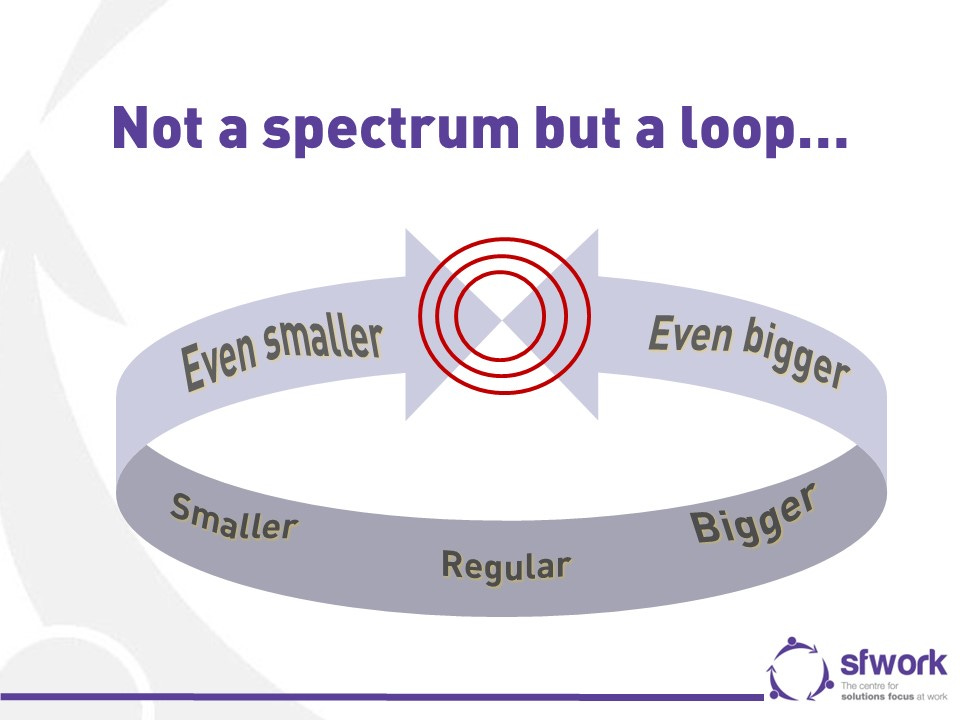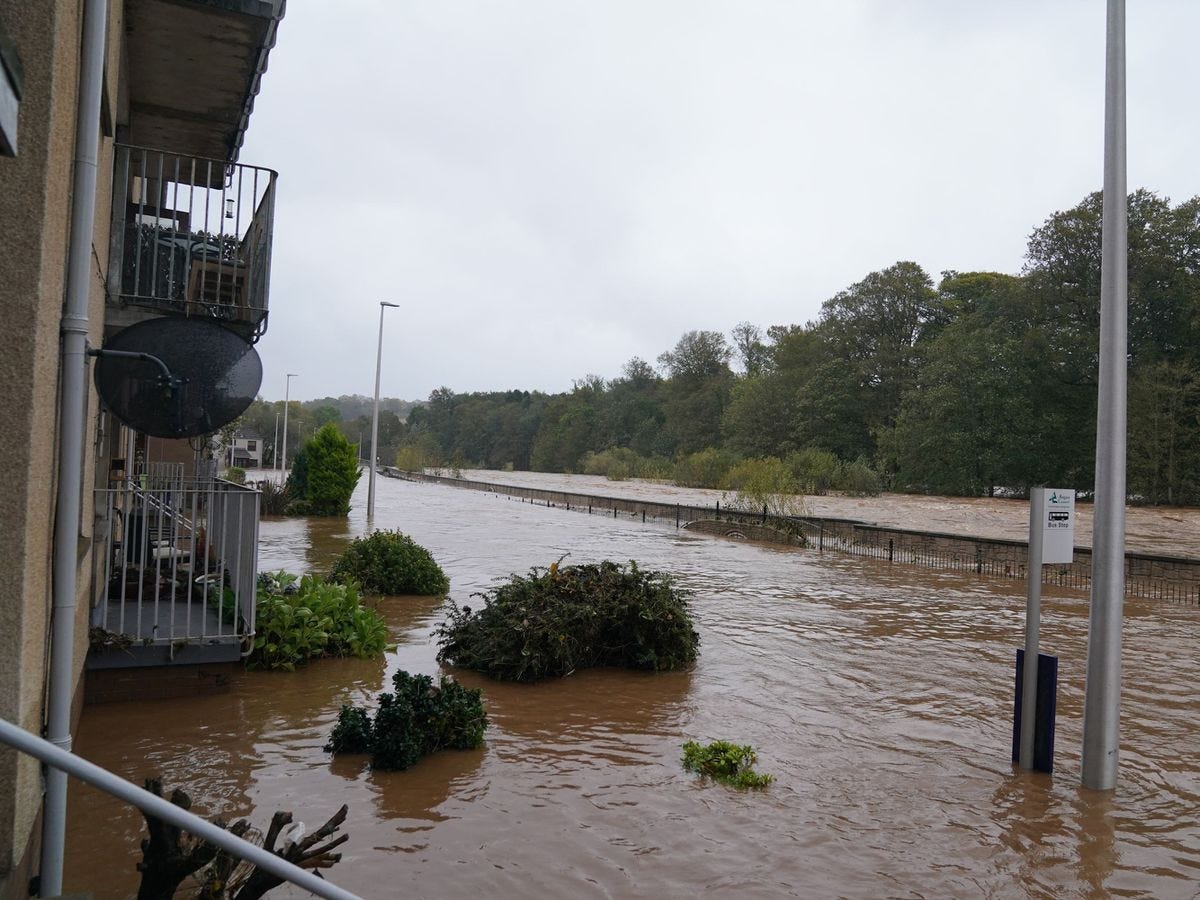33. Zooming out AND zooming in AT THE SAME TIME – the secret of Solution Focus
Including both wide context and tiny detail at the same time is a key and often unremarked part of Solution Focused (SF) practice for building progress in tough situations.
Last time I wrote about the wisdom of ‘zooming out’ – looking at wider contexts, broad geographic/space factors and also wide timescales. We saw how looking at the bigger picture is often helpful; it informs better decisions about next steps, and even if you can’t please everyone, then acknowledging that fact helps them to feel part of the picture, and you to look more aware.
This time we’ll build on that idea to see how working with a Solution Focused (SF) approach helps you by zooming both out and in AT THE SAME TIME. I think this is an under-discussed way to look at SF work and I’ll be interested to hear what you think too.
Not a spectrum but a circle
The brilliant English comedian Eddie Izzard has a section in his 1996 show The Definite Article (can it really be that long ago?) where he talks about looking cool. He says (at about 1h 16mins into the show, but you can go directly to it here):
“Cool is a pursuit of youth. There is a fashion c(ircle), it’s a fashion link thing being cool, it’s linked in a circle. You’ve got ‘looking like a dickhead’ over here, ‘average looking’, then kind of cool, cool, cool, hip and groovy, looking like a dickhead! I have been known to cruise in that back area. I can walk down the street and get these opposite reactions – people go ‘hey!’, ‘wurgh!’…”
I love this idea that what might appear to be a spectrum running from one end to the other might actually be a loop where the extremes join up around the back (where we don’t often look so don’t notice). In Izzard’s mind there is only a hair’s breadth between looking cool, hip and groovy and looking like a dickhead. Indeed, the precise point of joining is also a bit uncertain which is what makes for the fun of it. (In passing, there have been a number of attempts to see the political hard-left and hard-right in this way; it’s called the horseshoe theory and it’s not very well supported, but there we are.)
Zooming out questions
One way to look at zooming out and in is as a spectrum of detail with differently sized questions (see the illustration below). The kind of regular level of detail has ordinary everyday questions, such as (in an organisational context);
What are our goals for next year?
Who is responsible for what in this project?
Can you get me that report by the end of the month?
How can we sell more widgets in the next quarter?
These are perfectly good questions. Incidentally, they are all to some extent already solution-focused as they are linked to better futures and what’s working rather than dealing with the problematic past. That might bring questions of similar detail but different focus like ‘Why didn’t we achieve our goals last year?’, ‘Who the hell was supposed to be responsible for that project?’ and ‘Don’t tell me, the report is late again huh?’. 😊
However, what happens when we zoom out? The questions can get much bigger, wide-ranging and all-encompassing. A lot of SF questions are future focused and are less about establishing the facts than stretching our ideas about what might be included. So, to zoom out from
What are our goals for next year?
We might get to something like:
Suppose… that next year went amazingly well and we included all our stakeholders.. Where might we be?
Of course this is just a start. A conversation might ensure about what ‘amazingly well’ might look like, who the relevant stakeholder are, what their idea of a good year for all might summon up, and so on. I always like to include the local community in such conversations, as well as the organisation, the head office, the customers, the workforce etc.
Now, this is a worthwhile question on its own. We could (and do) take time to unpack it. It’s much wider in scope than the original starting point.
Zooming in questions
Zooming out is about making questions wider in scope. Zooming in, then, is about making the questions narrower, more focused and more detailed. So, in the current example:
What are our goals for next year?
We can zoom in to get to something like
What might be the first tiny signs to tell us that we’re on track?
It’s still all about success next year – but this time we’re looking at something much closer in time, much more focused. We could build the detail of this zoomed-in question by asking something like:
Who else would be the first to notice we were on track? What would they notice?
What difference would it make that we were on track? What difference would it make to the other stakeholders?
What else would be happening then?
Notice again that these are not simple fact-gathering questions. They are designed to increase our awareness of the unfolding situation. I wrote about the importance of these tiny signs and detailed questions in a previous piece here on Small Steps and Tiny Signs (#29).
Not a spectrum but a circle
Let’s go back to Eddie Izzard’s circle of fashion, where ‘looking cool, hip and groovy’ and ‘looking like a dickhead’ are not opposite ends of a spectrum but are right next to each other. We can apply the same thinking to levels of detail. So our spectrum of differently sized questions can into a loop like this:
We can zoom out from a question in one direction, and zoom in in another direction, and eventually come to the place ‘around the back’ (in Eddie Izzard terms) where they meet. I think this is a really interesting and under-explored place. It seems counterintuitive that it could even exist. But examine SF questions, particularly those I call next-generation SF questions, and we see this happening again and again. Zoom out with a really big, unexpected and surprising context, and at the same time zoom in with detail, tiny signs, small interactions between those involved.
So, if we start with the original everyday question about what are our goals for next year and zoom and in at the same time, we end up with something like this:
Suppose… that next year went amazingly well and we included all our stakeholders.. what might be the first tiny signs that told us we were on track?
This question is pulling in both ‘directions’ at once. But they are not opposite directions, they are the same direction! (That direction is ‘better’, by the way.) It’s a very unusual question indeed. Which is why a very standard initial response is:
“Ummmm….”
This is usually a very good sign indeed. The person is taking your strange question seriously and is grappling with it. As a practitioner, the thing to do is not interrupt their thinking but stay silent, still and look expectant. They may say ‘Oomph, that’s hard…’, in which case I nod gravely and do as little as possible to acknowledge that it is indeed hard, and it’s also very useful. Then when answers start to come, they often start slowly. We can build them up with questions like:
Who else would notice this happening? What would be the first sign they noticed? What else?
What difference would that make to you? To person P? To group G? What else?
What would be the next thing that would happen?
And as this conversation goes on, the world of the client is stretched and new possibilities emerge.
An example from Scotland this week
We have had some dreadful flooding in Scotland over the past week or so. Storm Babet arrived, bringing torrential rain to the counties of Angus and southeast Aberdeenshire. The town of Brechin was particularly badly affected, with substantial flood defences breached and the river running at some five metres (!) above normal. (The flood defences were built to withstand 3.8m, but…). There has also been serious disruption and loss of life in the English Midlands.
Local authorities had plans in place, and hundreds of people were evacuated to shelters. Three people lost their lives, swept away or trapped in submerged cars. The clear-up will take months if not years to repair the damage and restore flooded homes.
Scottish First Minister Humza Yousaf seems to have a good grasp of how to connect the very big and the very small. He visited the scene the following day, met the locals, acknowledged how hard it was for them and offered government support to recover. Yes, a visit isn’t much on its own – but it IS a first sign that events are being taken seriously at the highest levels in the Scottish Government’s Holyrood administration.
This is in contrast to, for example, US President George W Bush’s initial response to Hurricane Katrina and the overwhelming of the levees in New Orleans in 2005. On holiday at his Texas ranch at the time of the incident, Bush returned to Washington and asked to fly over the flooded area en route. I’m sure he had good intentions, but in terms of signs it was a disaster. Photos of the President looking out of his luxury plane at a very safe height at people still struggling for their lives were not well received. This event was said in some circles to be the beginning of the end for his reputation.

No doubt Bush was saying to his advisors that he didn’t want to get in the way of the rescue operations or cause a distraction. Shame he didn’t think about the bigger picture. We had a similar series of events in the UK after the shocking Grenfell Tower fire which claimed 79 lives in 2017. Prime Minister Theresa May, never the most outgoing of people, stayed away with similar suggestions of not getting in the way. She later said her response was ‘not good enough’. Opposition leader Jeremy Corbyn, oft-criticised and derided, picked up the situation much more deftly; a London MP and very comfortable with a crowd, he was on site within hours and gained considerable kudos for his initial engagement.
Conclusions
The way SF practice can zoom out and in AT THE SAME TIME is, I propose, one key reason why it’s so effective at finding ways forward in very tough situations. And an awareness of the importance of tiny signs in terms not only of making progress but also of wider perceptions, is key for anyone wishing to build a humane and effective organisation.
Please like, share and subscribe to these posts if you haven’t already. Thank you. They are free in 2023, and that may not last for ever.
Dates and mates
As editor of the Journal of Solution Focused Practices, I am gathering the latest research into SF work around the world. Have you written something on the subject? Have you seen something in the past year or so that was interesting? Do please comment below or drop me a line at mark@sfwork.com.






